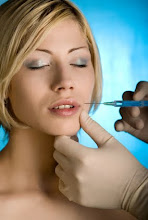Its ability to inject a wonderfully paralyzing and youthful appearance into scores of celebrity and non–celebrity faces was discovered 15 years ago, Mapes writes. But it wasn’t until five years ago that Botox received FDA approval. Take a trip back in time to see how Botox evolved to be the poison of all poisons and the prettiest one.
It all began with the sausage in the 1820’s when Dr. Justinus Kerner conducted case studies and experiments to learn what was behind the deaths of some Germans who had consumed sausage. Turns out it was food–borne botulism. Thanks to Dr. Kerner, we found out more about this poison, including its neurological symptoms—from droopy eyelids to respiratory failure—and using it therapeutically. Then in the 1890’s Dr. Emile Pierre van Ermengem from Belgium identified strains A through G of botulinum toxin, four of which—A, B, E and F—can make us humans sick.
Then in the 1940’s it was time to get creative and use the poison for bad. According to a 2004 article published in the journal Clinical Medicine, during WWII, there was a plan for Chinese prostitutes to plant capsules with botulinum toxin inside the food and drinks of high–ranking Japanese officials. But the poisonous plan never went through.
The 1950’s and 60’s welcomed the good side of botulinum. During these years, Dr. Edward J. Schantz and others purified botulinum toxin type A into crystalline form. Dr. Vernon Brooks discovered that small doses of botulinum relax the muscle temporarily. And ophthalmologist Dr. Alan B. Scott began injecting monkeys with the toxin believing it could help with crossed eyes.
Animal subjects were then replaced with humans in the next decade when Dr. Scott received government approval to use human participants in his scientific work. Results revealed that botulinum toxin type A was a safe and effective treatment for crossed eyes. Other research showed botulinum toxin was helpful in relieving all kinds of spasms from facial to vocal cord spasms. In 1989—a year after Allergen bought the distribution rights to the toxin—the FDA approved botulinum toxin type A for treating crossed eyes and spasms in the eye muscle. Soon Allergen went further and bought Dr. Scott’s company and “Botox” was born!
As more research was conducted, it was uncovered that Botox temporarily cured excessive sweating and cerebral palsy in the 1990’s. Then a serendipitous event occurred when ophthalmologist Dr. Jean Carruthers noticed her patients were looking fabulously wrinkle–free. After Dr. Carruthers and her husband’s (a dermatologist) study on Botox’s ability to decrease frown lines was published, Botox took off—so much so that we actually ran out of it in the late 90’s, but luckily only for a very short time.
With Botox Cosmetic officially approved in 2002 for fixing frown lines and then two years later for excessive underarm sweating, Allergen’s lucrative business has been booming with sales exceeding $1 billion in 2006.
Mapes also writes about a recent backlash with negative portrayals of Botox showing up in several television shows along with concerns about its misuse and the experience and professionalism of those doing the shooting, growing.



